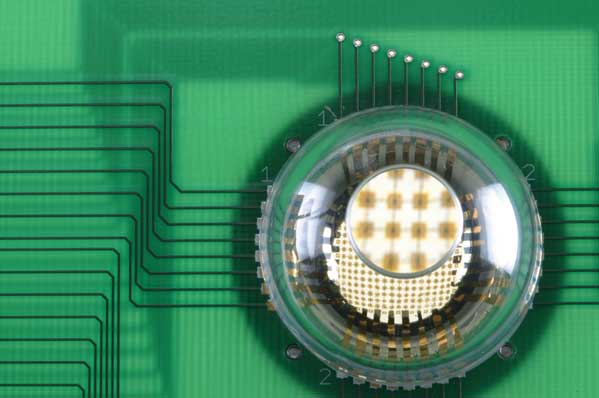Researchers Create a Bionic Eye
One of the key challenges of digital photography technology has been to try to capture images as well as the human eye does. While optics have made significant improvements in recent years, modest enhancements to the resolution density of the electronic sensors have kept the lofty goal of mimicking human perception as just a pipe dream. But scientists at the University of Illinois at Urbana-Champaign and Northwestern University have now made a breakthrough that might take a giant leap toward reproducing human-eye-like sight in an electronic sensor.
Their breakthrough comes in the form of liberating the light-sensing array from the traditional planar or flat surface, which tends to introduce "aberrations." The National Science Foundation (NSF) reports that that this has been a goal of researchers for "over the last 20 years." Like the shape of a retina, this new sensor is laid out on a hemispherical surface. Traditional digital camera sensors are laid out on a planar surface of contiguous pixels on a rigid substrate; flexing a traditional sensor more than one percent can fracture it. The researchers' new sensor design, however, positions the individual pixels on a "flexible mesh" of wires, which can flex up to 40 percent without putting any significant strain on the pixels--the wires absorb the bulk of the stress.
"This research is truly transformative," said Ken Chong, advisor in the National Science Foundation (NSF) Engineering Directorate, who is one of the officers overseeing the researchers' NSF grant. "Using simple mechanics principles, the researchers have produced, for the first time, electronic devices on a hemispherical surface so that they can take images much like those captured by the human eye."
This innovative approach to sensor design is not limited to just light-sensing cameras:
"Researchers are testing the same design principles in a range of other applications, including as a thin, conformable monitor to detect electrical signals traveling across the undulating surface of the human brain."
In fact, this approach can essentially be applied to "nearly any class of semiconductor electronic device for a range of functions such as sensing, actuating and computing." The researchers envision their technology having applications where electronics can be embedded into humans, such as perhaps artificial eyes:
"We believe that some of the most compelling areas of future application involve the intimate, conformal integration of electronics with the human body, in ways that are inconceivable using established technologies," said Rogers, who is also affiliated with the Beckman Institute for Advanced Science and Technology and the Frederick Seitz Materials Research Laboratory. "We are working actively with collaborators to explore possibilities in advanced health monitors, prosthetic devices and therapeutic systems."
The current iteration of the sensor design contains only 256 pixels. However, since the technology utilizes materials and processes that are already used by traditional digital camera sensors, the researchers anticipate that their method should be able to scale up to house a "higher density array."
Their breakthrough comes in the form of liberating the light-sensing array from the traditional planar or flat surface, which tends to introduce "aberrations." The National Science Foundation (NSF) reports that that this has been a goal of researchers for "over the last 20 years." Like the shape of a retina, this new sensor is laid out on a hemispherical surface. Traditional digital camera sensors are laid out on a planar surface of contiguous pixels on a rigid substrate; flexing a traditional sensor more than one percent can fracture it. The researchers' new sensor design, however, positions the individual pixels on a "flexible mesh" of wires, which can flex up to 40 percent without putting any significant strain on the pixels--the wires absorb the bulk of the stress.
Credit: Beckman Institute, University of Illinois
"This research is truly transformative," said Ken Chong, advisor in the National Science Foundation (NSF) Engineering Directorate, who is one of the officers overseeing the researchers' NSF grant. "Using simple mechanics principles, the researchers have produced, for the first time, electronic devices on a hemispherical surface so that they can take images much like those captured by the human eye."
This innovative approach to sensor design is not limited to just light-sensing cameras:
"Researchers are testing the same design principles in a range of other applications, including as a thin, conformable monitor to detect electrical signals traveling across the undulating surface of the human brain."
Credit: Beckman Institute, University of Illinois
In fact, this approach can essentially be applied to "nearly any class of semiconductor electronic device for a range of functions such as sensing, actuating and computing." The researchers envision their technology having applications where electronics can be embedded into humans, such as perhaps artificial eyes:
"We believe that some of the most compelling areas of future application involve the intimate, conformal integration of electronics with the human body, in ways that are inconceivable using established technologies," said Rogers, who is also affiliated with the Beckman Institute for Advanced Science and Technology and the Frederick Seitz Materials Research Laboratory. "We are working actively with collaborators to explore possibilities in advanced health monitors, prosthetic devices and therapeutic systems."
Credit: Beckman Institute, University of Illinois
The current iteration of the sensor design contains only 256 pixels. However, since the technology utilizes materials and processes that are already used by traditional digital camera sensors, the researchers anticipate that their method should be able to scale up to house a "higher density array."




